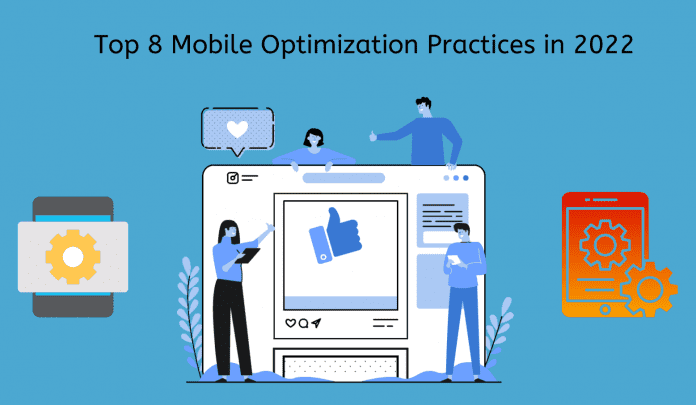Last Updated on January 27, 2024 by Asfa Rasheed
For a very long time, responsive design was the preferred web format for both commercial and private websites. But now, mobile optimization is gaining traction as a possibly superior tactic.
A website’s optimization for mobile devices is referred to as mobile optimization.
You build the complete experience for smaller screens rather than merely condensing and slightly rearranging the content on the net.
Table of Contents
Do we really need mobile optimization?
If you’ve ever used a mobile device to view a website, you know how difficult it can be. Tiny buttons and links, never-ending scrolling, and ambiguous form fields all cause difficulties that frequently lead to desertion.
The population is harried, anxious, and irritable. They won’t waste time trying to figure out how to add items to their shopping baskets or waiting for a delayed page to load.
Friction is the key to everything. The less likely a customer is to convert, the more friction a website generates.
When there is a barrier to conversion, friction happens. Customers experience friction when they are required to exert more effort than is necessary to complete a task. That customer feels inclined to avoid the encounter completely.
Imagine you use your smartphone to open an online business, for instance. You wish to purchase some headphones with noise cancellation.
Your first attempt to use the search function, but the search button isn’t responding. Then you try to use the top-bar menu to find the needed product.
When you do locate a list of headphones that are for sale, you must tap each one to examine its specifications. Then, to obtain the data you require, you might have to pinch, scroll, and perform other screen manipulations.
Never bother contrasting one item with another. Other than tapping back and forth, there isn’t any other choice.
More scrolling and pinching. After that, you must confirm by email.
Each of these irritations produces friction. Many mobile users would give up on their search because they are impatient or out of time.
How a Website That Is Mobile-Optimized Can Affect Your Conversion Rate?
By lowering friction, the mobile optimization strategy promotes conversions.
The worldwide conversion rate for desktop computers was 3.63 percent in the first quarter of 2016. That’s not very good. However, the global smartphone conversion rate was a dismal 1.25 percent.
Mobile users not only access the Internet more frequently than desktop and laptop users but also utilize their devices for twice as long.
These figures make it evident that mobile optimization is crucial for business owners. However, how might it impact your conversion rate?
These attributes all work to lessen friction. A business will probably profit from your patronage if you can purchase a good or service through your mobile device without wishing to pitch your device across the room.
Naturally, there are a variety of approaches to preparing your website for mobile consumers. The simplest and most common approach is probably responsive design, but you also need to consider other options.
How can we expand our business with mobile optimization? Let’s find out!
1) Decide on a web design that is fully responsive.
Choosing a responsive design is the best method to begin mobile site optimization. Instead of a top bar, the “cheese burst pizza” menu frequently displays, and the size of the photos decreases.
But keep in mind that mobile optimization and responsive design are not the same. The foundation for creating a fully mobile-ready site is responsive design, which is where mobile optimization simply begins.
A responsive site differs significantly from a mobile-optimized design when viewed on a mobile device. It frequently has a different URL and is set up with the needs of the mobile user in mind.
The need to pinch and scroll is decreased, the buttons are sized for broad fingertips, and the pictures are lighter to slow down page speed.
But if you start with a responsive design, you’ll be on the right track.
The first step toward increasing mobile device conversion rates is ensuring that your website is visually appealing and easy to use for all users.
If you wish to learn more about responsive designs and their impact on website optimization you can enroll in the best digital marketing courses in Pune, which would help you to get a better understanding of use.
2) Rely on structured data
Rich snippets can be displayed by Google and other search engines thanks to structured data.
Rich snippets are a type of HTML code that you may add to your website to provide search engines with additional data.
On a Google search results page, rich snippets frequently show above the sponsored and organic results.
People may locate your dishes in a rich snippet if you sell kitchenware and post recipes on your site. Direct links to simple instructions can be found in the SERPs.
3) Image compression
Your site will become “heavier” and load more slowly if you use large image files. You can avoid these problems by compressing your photos using a plugin like Smush Image. If you’re using a different URL for your mobile users, think about sending fresh, smaller photos.
In this approach, the screen won’t be overrun with graphics or load slowly.
Product images are a great example. The ideal image should be big enough for customers to see it well but barely noticeable in terms of how quickly a website loads.
4) Identify elements that are not mobile-friendly

Your website may have components that won’t work well on mobile devices.
Consider sidebars, for instance. Typically, a sidebar will be on the page’s left or right. Some scroll down as you scroll, while others are static.
On a mobile device, a sidebar might make the body text difficult to see without pinching the screen.
5) Add AMP
You may enable AMP functionality for your WordPress installation by installing the plugin. Due to AMP, your website’s look and feel change when visited on a mobile device.
Your AMP can be customized to have the style and feel you desire and to reflect your brand.
AMP websites load more quickly than regular websites do. The goal is to display a scaled-down version of the cached website. It stands to reason that readers will want to stay if the page loads more quickly.
6) Test using pop-ups
Popups can be a wonderful addition to your website but only provided they don’t interfere with its functionality or alienate visitors.
Popups on mobile devices can be very annoying because users frequently are unaware of how to remove them.
To find out if they affect bounce rates and other crucial KPIs, think about A/B testing them.
Your brand might benefit from popups. Disable them if they don’t comply. But until they’ve been put to the test, don’t assume they’re ineffective.
7) Insert videos
On mobile devices, images can quickly become quite constrained. You must either arrange them side by side, in a carousel, or stacked on top of one another.
However, the video may captivate visitors both aesthetically and audibly without detracting from the aesthetics of your website or their user experience. For example, explainer videos effectively educate viewers about your product or service.
Additionally, you may use product films to showcase your goods and even make brief commercials.
Test various video formats to determine which ones your audience prefers. You might also produce instructional videos to counteract your blog entries that are primarily text-based.
8) Avoid using Flash.
Flash components slow down your website and don’t always display correctly on mobile. People won’t be able to communicate with your company online if your website depends on Flash because neither the Android nor the iPhone operating systems support it.
Apart from that, if you are interested to know about The Art and Science of Developing Mobile Apps With Performance in Mind then visit our Technology category.
















